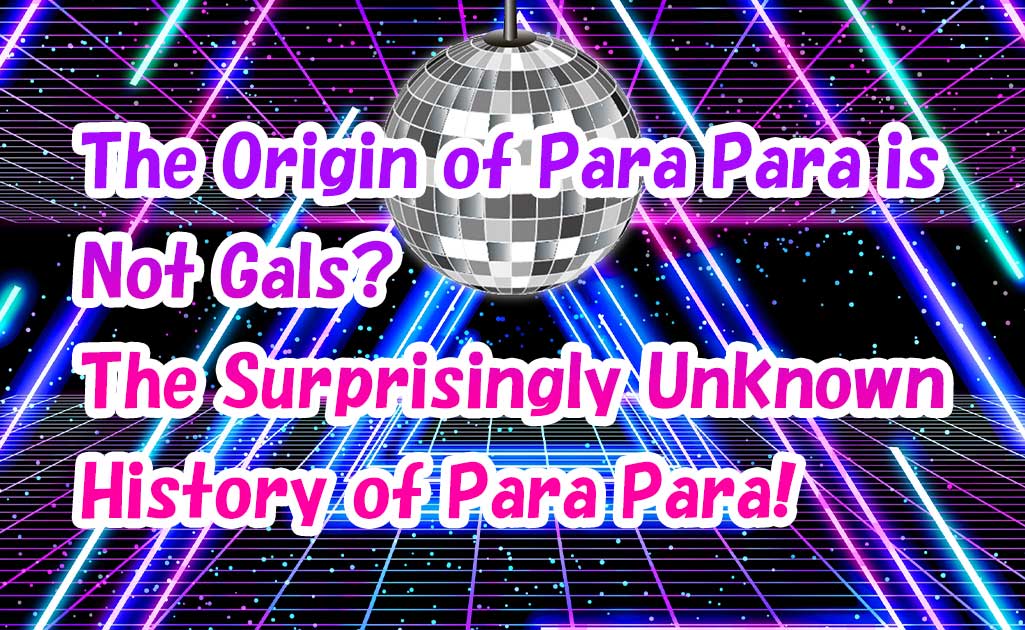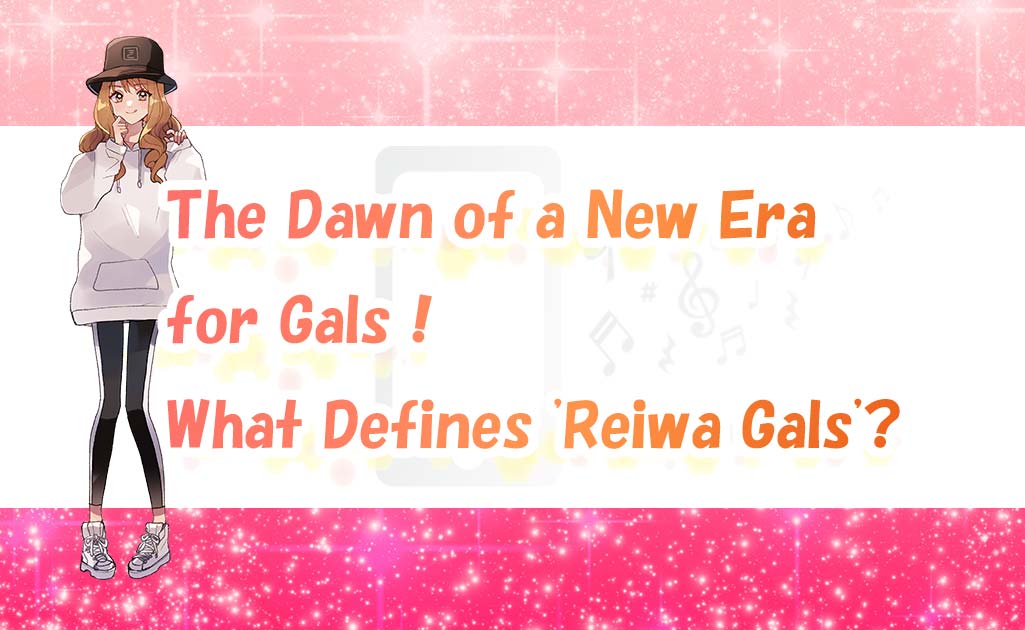Para para was all the rage during the heyday of ganguro () Gals.
- "Para Para is something that Gals dance to"
- "Para Para was created by Gals"
Many people have this impression, but the first ParaPara boom actually happened a long time ago.
The first Para Para boom was actually started by a surprising group of people, not the Gals!
.Ganguro… A style of Gals around 1998 to the early 2000s who went to great lengths to tan their skin and appear darker."
What exactly is Para Para?
"Para Para" refers to a dance composed of gestures and hand movements, performed to the fast tempo of Eurobeat, a genre of dance music.
Many people mistakenly think of it as a genre of music, but Para Para is, in fact, a type of dance, similar to rock dance or breakdance.
The origin of Para Para dates back to 1980.
It is said that it began when students at Meiji Gakuin University spontaneously danced the "Exercises that do not synchronize the arms" that they learned in physical education class at a discotheque called Tsubaki House.
Characteristic of Para Para are movement that involves simply moving your feet from side to side(2-step) and Sharp hand movements such as spreading and crossing both hands.
Thus, Para Para can be considered a unique dance, distinct from other dance forms. Furthermore, it is relatively easy to learn compared to other dances, making it an accessible dance style for beginners.
When is the boom? History of Para Para.
The First Para Para boom.
During the peak of Japan's economic bubble, in the late 1980s to 1990.
Primarily in clubs and discos, staff members dressed in black, also known as "Kurofuku ()," choreographed and performed dances themselves to attract more customers, spreading Para Para as a part of their entertainment offerings.
Para Para quickly gained popularity with many customers, and at the time, it was common practice to go to clubs to learn choreography.
At this time, Para Para didn't dance to the full version of a song, but often only danced to the chorus.
Moreover, since the Kurofuku staff themselves devised the choreography, it varied from one establishment to another.
.Kurofuku… Male employees working in discos and clubs (occasionally, there were female employees as well).
The Second Para Para boom.
In the early Heisei period from the mid-1990s to the late 1990s.
In 1994, record companies released videos titled "Para Para Kyoten" (Para Para Teaching Manuals), making it possible for people to easily learn and dance Para Para at home.
From this period, people began dancing not just to the chorus but from the intro of songs, leading to a growing interest in Para Para among the youth.
This surge in popularity was influenced by the release of Namie Amuro's "TRY ME Watashi wo Shinjite" in 1995 and the Japanese female dance group MAX's "TORATORATORA" in 1996, both of which contributed to the rising popularity of Eurobeat music.
The Third Para Para boom.
Late 1990s to early 2000s, coinciding with the peak of the Ganguro Gals era.
This period can be considered the height of Para Para's popularity.
A significant factor in this boom was the influence of Takuya Kimura, who, on the TV show "SMAP×SMAP," performed Para Para while dressed as his character "Bucky Kimura."
This sparked a Para Para craze, particularly among Ganguro Gals and male counterparts.
Additionally, the debut of "Para Para All Stars" by avex in 1999, along with Mickey and Minnie Mouse performing Para Para, and the character Conan from "Detective Conan" doing Para Para in the anime's opening sequence, made the Para Para increasingly mainstream.
The "Para Para All Stars" were particularly influential, often referred to as the "Charismas" or "Gods" of Para Para, becoming indispensable figures for those who danced Para Para at the time.
In 2001, Konami released a dance game machine titled "Para Para All Stars," which also contributed to a Para Para fever in game centers.
Additionally, the popularity of Eurobeat remixes of hit songs by artists like Ayumi Hamasaki and Every Little Thing was characteristic of this era.
These factors led to Para Para's widespread popularity, transcending generations and extending beyond the Gal culture to the general public.
Moreover, the inclusion of "Para Para" in the 2000 Buzzword of the year awards reflects the high level of popularity Para Para enjoyed at the time.
Post-2002 Era.
The Para Para boom had significantly subsided, with the dance being seen primarily at events held by Gal Circles ().
.Gal Circles… Social groups primarily composed of high school-aged Gals and Gal-o counterparts.
These groups would meet weekly in Shibuya Center Street for taking Purikura (photo booth pictures), discussions about their youth-centric events, other activities.
During this period, Para Para became notable in different contexts, such as the comedian Chosyu Koriki performing Para Para to "NIGHT OF FIRE," and the song "Dragostea Din Tei" being used for Para Para.
In 2007, Tsubasa Masuwaka, who was popular in the magazine "Popteen" at the time, released "Magic to Love".
This song was included in a DVD called "Gazen-parapara" where you can learn how to dance parapara, and it attracted attention.
Although in 2018, Thelma Aoyama's music video for "Sekai no Chushin We are the world" showed her dancing Para Para with Gals in front of Shibuya 109, it did not lead to a full-scale revival.
However, around 2020, Para Para started gaining attention among young people again, with videos of the dance frequently posted on social media.
Notable trends included cosplayers of the popular anime "Demon Slayer: Kimetsu no Yaiba" dancing Para Para to the theme song and new-generation egg magazine Gal models performing Para Para, receiving positive feedback for their "cuteness."
With these developments, there's a hint that a new Para Para boom might be on the horizon after many years.
Who? Where did you dance Para Para?
During the First for Second Para Para boom.
Para Para, initially popularized as an act performed by performance of Kurofuku, was predominantly danced by working adults such as office ladies (OLs) and salarymen in discos and clubs.
Women dressed in bodycon dresses dancing on standing stand were seen as figures of admiration by other female patrons.
However, only advanced dancers could ascend these standing stand.
To qualify, one needed to master the choreography of at least 100 songs, which meant frequent visits to discos and clubs to learn the moves were a common practice.
During the Second boom, with the release of Para Para videos, it became possible for people dance Para Para at home.
During the Third Para Para boom.
Influenced by celebrities like Takuya Kimura and other factors, there was a significant increase in the number of Gals and male counterparts dancing Para Para.
It became mainstream for gals and Gal-O under the age of 20 who could not go to clubs to dance outdoors, such as in parks or on the streets.
Additionally, members of Gal Circles, commonly referred to as "Sar-jin" (circle people), would often dance in groups, and their performances at outdoor events became increasingly featured in the media.
Consequently, this period solidified the image of Para Para as a dance predominantly associated with the Gal culture.
Here's an introduction to some of the famous songs that were popularly danced to in Para Para.
"TAKE ON ME" by A-HA
A song deeply connected to the history of Para Para.
A phrase in this song is said to be the origin of the name "Para Para."
"TRY ME ~Watashi wo Shinjite~" by Namie Amuro
This song ignited the Second Para Para boom.
Continues to be a popular track for many people.
"NIGHT OF FIRE" by NIKO
Comedian Choushu Koriki used this song in his performance, and it is one of the highly recognized songs that made ParaPara popular throughout the world.
Many people might have discovered Para Para through this song.
"MICKEY MOUSE MARCH" by Domino
A remix version of the famous song "MICKEY MOUSE MARCH" that is loved by many people was also used in Para Para.
Interestingly, Mickey and Minnie Mouse have danced Para Para to this song in Disney parks.
Its easy choreography makes it enjoyable for both children and adults.
"BOOM BOOM FIRE" by D.ESSEX
Known for its distinctive choreography, resembling the "Ai-n!"
gesture, this song has somewhat more complex movements compared to other tracks.
"YESTERDAY" by CHERRY
A well-known song among Para Para enthusiasts, it's recognized for its easy-to-learn choreography.
"BAD BOY" by Cascade
This is another very popular Para Para song.
It is characterized by the absence of leg movements that move from side to side, which is known as a 2-step.
Recently, videos of young people performing Para Para to this song have become popular on TikTok.
"LOVE&JOY" by Yuki Kimura
Particularly popular among women, this song features relatively simple and adorable choreography.
Many of you may know this song, as it was also played on Purikura machines.
And more.
- JEALOUSY/VIRGINELLE
- One Night In Arabia/GO GO GIRLS
- I Wanna Dance/DOMINO
- My Sweet Banana/GO GO GIRLS
- JAM JAM JAM/ KIKI & KIKA
- TORA TORA TORA/DOMINO
- Burning Desire/MEGA NRG MAN
- velfarre2000/BAZOOKA GIRLS
- scorpion/ORIENTAL SPACE
- NUMBER ONE/FASTWAY
- IKEIKE(イケイケ)/TRI-STAR
The image that "Para Para = Gals" has been established, but it turns out that it was during the third Para Para boom that Parapara became popular among Gals.
The origin of Para Para, stemming from college students dancing a gymnastics learned in physical education class at a disco, is quite surprising.
The fact that Disney characters like Mickey Mouse and Minnie Mouse performed Para Para shows that it was a dance enjoyed by a wide range of people, from children to adults, and not just limited to the Gal community.
In recent years, it seems that enthusiasm for Para Para is growing again, with Para Para dancing being posted on YouTube and TikTok.
Will it really become a boom again?
I really want Para Para, which can be called Japanese culture, to be inherited.


